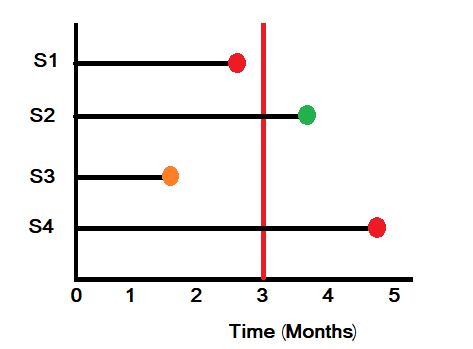I am working on an analysis seeking to predict early death which is defined as death within 3 months of the start of treatment. What is the best way to analyze this since there is censoring involved in this analysis (See subject S3 below). Specifically, per the picture below, in an analysis of early death, it is clear to me that:
- S1 would be considered Yes, an early death, because the subject had the event within 3 months.
- S2 would be considered No, not an early death, because it is known that the subject did not have an event within 3 months.
- S4 would be considered No, not an early death, because the subject had the event after 3 months.
The issue is with subject S3. Up to ~2 months, the subject has not had the event, but classifying this subject as “No, not an early death” would not be correct because this subject has not reached 3 months follow-up and could in theory have an event at 2.5 months.
Some thoughts about options to analyze this data appropriately include:
- Analyzing this data with a multinomial model (S1=Yes, S2 and S4=No, S3=Not Evaluable)
- Analyzing this data with a binary model, excluding subject S3
- Analyzing this as time to event data in some fashion. Although I think results will likely inform us of which subjects are more likely to early progress earlier, as opposed to which subjects are more likely to be early progressors.
- Applying an imputation strategy (e.g., MICE) to impute plausible values for early death in censored subjects.
Would really appreciate any thoughts on this
